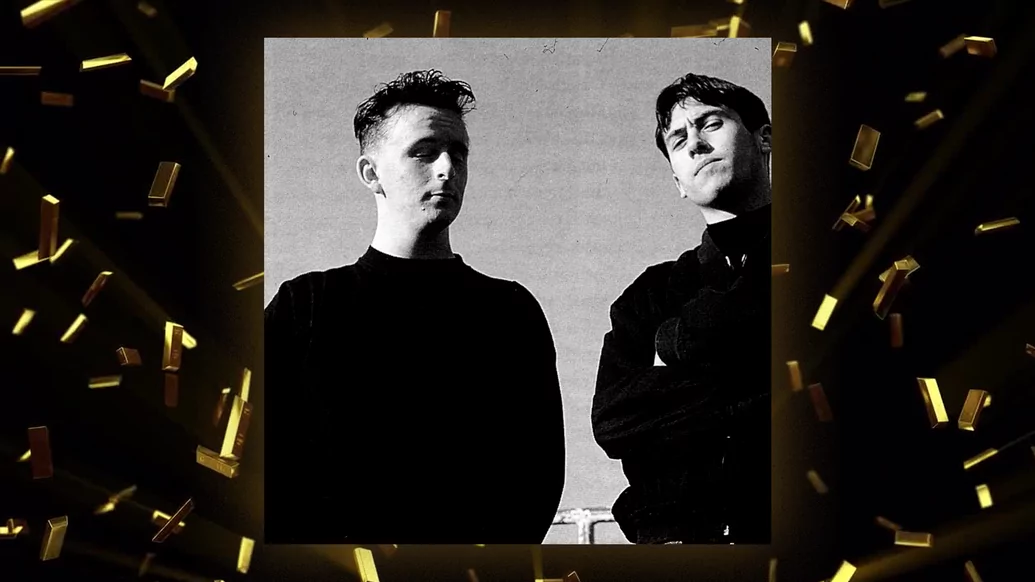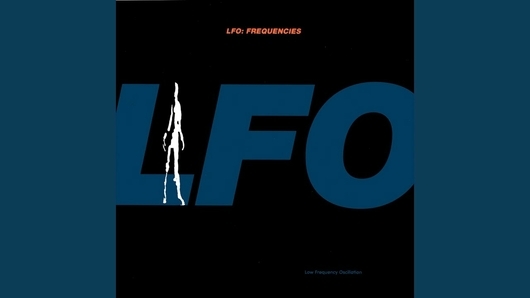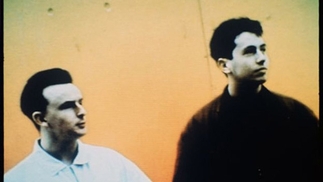
How LFO's 'Frequencies' became a benchmark for '90s bleep techno
Mark Bell and Gez Varley’s 1991 debut album as LFO, 'Frequencies' on Warp Records, encapsulated dance music’s past, present and future, and became a benchmark for the bleep techno sound. Here, Ben Cardew revisits the influential album
Sometime around the early ’90s, a lot of UK rave music went from sounding ecstatic to something grittier. Maybe it was the drugs. Maybe it was the police crackdowns. But music that had once strived for a promised land had shifted its gaze.
Leeds duo LFO — aka the late Mark Bell and Gez Varley — weren’t really a rave band, despite the popularity of their debut single ‘LFO (Leeds Warehouse Mix)’ on 1990’s rave scene. But the duo’s debut album, ‘Frequencies’, seemed to perfectly encapsulate a certain part of dance music’s shift to the dark side on its release in 1991. Put bluntly, there was something elegantly terrifying in LFO’s music, a mixture of beautifully somber synth melodies, speaker-cracking bass and the acidic bleeps that would lend their name to the brief but much-loved bleep scene of the early 1990s.
‘We Are Back', the band’s second single, uses its title more as a threat than a promise, a crunching, distorted computer voice announces that the band have returned, as if intent on slashing your curtains, over a pounding kick drum, synth melody on the verge of a nervous breakdown and corpulent sub bass.
LFO weren’t quite the first act to hit on the classic bleep techno combination of sub-bass, electro and acid. Released in 1989, ‘The Theme’, the debut single from Bradford, England’s Unique 3, was probably the first bleep techno tune. Even so, LFO’s eponymous debut single, released in summer 1990 and an unlikely Number 12 UK chart hit, sounded like little else in electronic music. Sure, it had influences: dub in the epic bass line, house in the drums, electro and acid house in the needle-sharp synth work. But these were welded together in a way that still sounds shocking today, as if that sort of bass should never go with those sorts of drums.
‘LFO (Leeds Warehouse Mix)’ also pulls off the rare trick of sounding both raw — the bass apparently comes from a Casio sampler — and incredibly clean, as if created under strict laboratory conditions for maximum bite. ‘The Theme’ was brilliant but slightly fuzzy around the edges, as if the group was still working their way towards the trademark bleep sound; ‘LFO (Leeds Warehouse Mix)’ was as clean as a cut from a surgical knife, a distillation of pure dance steel. The record is simultaneously minimalist — with only seven parts, according to Varley — and utterly vast sounding, each element as imposing as a giant marble monolith. That it was makes the album, made by two men still in their teenage years, who didn’t appear too concerned about musical immortality, even more wild.
“When I was 14-and-a-half I bought an 808 from my first girlfriend’s dad for 25 pounds (he used to do ’Lady In Red’-style demos with it)," Bell told The Milk Factory in 2002. "I was really into hip-hop and electro and I wanted to try and make some beats of my own. When I left school I did a graphics and photography course, where I met Gez (Varley) and Martin (Williams). Martin used to DJ at a club in Leeds called the Warehouse, Gez used to break at the same silly places I used to when we were about 13." Varley and Bell put together some second-hand synths, recorded the results on a four-track, and Williams would play the results in his DJ sets, also offering the duo advice on how to make their music slightly more dancefloor friendly, winning himself a credit on their debut single on the way.
‘LFO’ was a huge dance hit in the UK — DJ Ben Sims told Kirk Degiorgio for Resident Advisor's Rewind feature in 2019 that he must have heard it 20 times across London in the first weekend it was released — and the duo signed to Warp Records on an album deal. Full of ideas and teenage mettle, LFO recorded their debut album in a year, with ‘Frequencies’ released in July 1991. Bell later claimed that he wrote most of ‘Frequencies’ on his own because Varley wanted to make more direct dance music, although Varley himself has talked of the two working together on the album.
At that time, the idea of an album of electronic music was still a relative novelty — particularly for a duo that came from the UK’s club scene — and LFO made very few compromises towards the home listener over 14 tracks of hardcore, electronic soul. Only a handful of the album’s 14 tracks even considered dropping the duo’s trademark intensity for a moment and, of these, only ‘Think A Moment’ could be considered anywhere near a moment of relaxation. And yet, ‘Frequencies’ worked well for home listening thanks to the incredible strength of LFO’s melodies and the duo’s pristine production smarts, which meant their music could be enjoyed at both intensely high and surprisingly low volumes

It’s easy to see a through line from ‘Frequencies’ to Warp’s landmark ‘Artificial Intelligence’ compilation, which was released the following year, trumpeting the idea of “electronic listening music.” ‘Simon From Sydney’, for example, has a melody of low-key, neoclassical beauty that you could imagine gracing Aphex Twin’s ‘Selected Ambient Works 2’ several years later. In fact, Birmingham post rock band Pram would mould together ‘Simon From Sydney’ and ‘SAW2’’s ‘Yellow Calx’ in a cover for the ‘Warp 10+3’ album in 1999. ‘Tan Ta Ra’, another highlight of ‘Frequencies’, has the kind of melody you might find yourself idly whistling while waiting for a bus, played out over a collection of metallic bell sounds that send a shiver up the spine, not so much chilled as entirely chilling.
What was most striking about ‘Frequencies’, however, was the way in which it jetted towards the future while keeping an eye on the past. The album opens with ‘Intro’, LFO’s ode to the greats of electronic music, which plays out to a suitable jacking beat, before ‘LFO (Leeds Warehouse Mix)’ arrives to wipe the slate clean. Later on, ‘You Have To Understand’ samples a vocal from Quest’s 1988 house classic, while ‘Love Is The Message’ appears to borrow a snatch of vocal from the same-named ‘88 house track by Maxtrack Orchestra. In both cases, the juxtaposition of icy keyboards, juddering beats and soulful vocals provides a fascinating fire-and-ice combination that Murk, renowned bleep fans, were certainly listening to.
Alongside hardcore, bleep was among the UK’s first domestic strands of dance music. But LFO never forgot their past, with traces of electro, techno, house, dub and Kraftwerk writ large across their debut album. The electro-ish beats and sweeping melodies on ‘Frequencies’ are very Kraftwerk, for instance — though the Düsseldorf masters would probably ruffle their noses at LFO’s great stinking amounts of bass.
‘Frequencies’ was another hit for LFO, reaching a respectable number 42 in the UK albums chart. Its influence, however, would spread far wider than any chart placing would suggest. As well as the role of ‘Frequencies’ in creating “electronic listening music” (and therefore IDM), Fabio and Grooverider were big fans of ‘LFO (Leeds Warehouse Mix)’, playing it at their seminal Rage club night where jungle was born, the track’s aggressive, immersive sub-bass later becoming a trademark of the jungle sound.
LFO themselves would go onto remix Radiohead, Depeche Mode and Björk, with Bell working extensively with the latter two acts. For Depeche Mode, he produced ‘Exciter’, the band’s tenth studio album, and Bell would become probably Björk’s most important collaborator, working on six of her albums from ‘Homogenic’ to 2011’s ‘Biophilia'. LFO’s second album, ‘Advance’, was five years in the making and if not quite as ground-breaking as their debut, was agreeably filthy on songs like ‘Tied Up’. Varley left the band soon after and Bell would release one further album as LFO, 2003’s ‘Sheath’, home to the all-time classic ‘Freak’, before his tragic death in 2014 at 43 years old.
After his death, electronic musicians including Disclosure, Carl Cox, Erol Alkan and Dave Clarke paid tribute to Bell. But perhaps the most moving message came from Björk, who tweeted a link to LFO’s ‘Love Is The Message’, ensuring there was barely a dry eye left on the internet, a fitting tribute to a band who embraced innovation, emotion and history, changing dance music history as they did it. LFO were true pioneers in their field; and ‘Frequencies’ was their calling card, the great bleep forward of early ’90s dance music.






